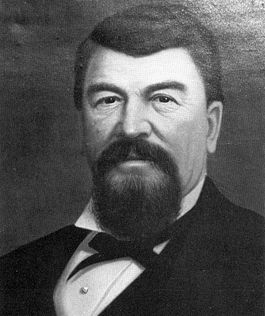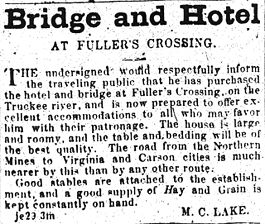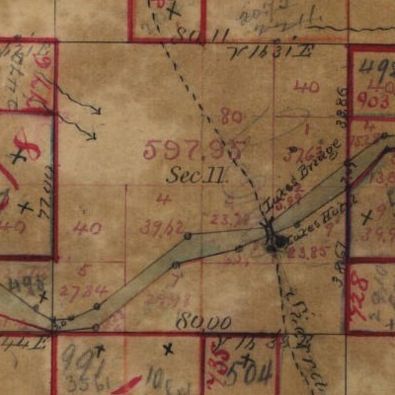Myron C. Lake
Myron Charles Lake (Feb. 1828-June 20, 1884), hotel-keeper/entrepreneur, was the hot-tempered, tight-fisted founder of Reno, Nevada. Between 1862 and 1873, Lake lorded over the town through his vast real estate holdings and monopolistic control of a vitally important toll bridge and road. He quickly assumed the posture of a stereotypical robber baron, and in an unhappy marriage, often resorted to domestic violence. But he also wielded a keen business acumen and in so doing, ensured that the Central Pacific Railroad during the building of the great transcontinental project would run through Reno, thereby initiating the growth and future prosperity of western Nevada.
Early life
Very little is known about Lake’s early years and much of what is known remains unclear. He was born in Cayuga County, New York state, the oldest of 7 children (5 boys, 2 girls) born to Catherine Van Tassell (1803-1874) of New York state and John Lake (1799-1877), of Maine. About 1839, the family moved to Paw Paw, DeKalb County, Illinois, about 70 miles west of Chicago.[1] Lake saw service during the Mexican-American War (1846-48) as an infantry private in Illinois’ volunteer Company D, First Regiment. Following the war, he returned home to establish a farm of 300 acres, comprised of a 160-acre government land grant and his personal acquistion of the rest.[2]
By 1852, he had moved on to Rabbit Creek, Calif. to try his hand at mining;[3] five years later, he moved intrastate to Honey Lake Valley, where he built a modest ranch. Evidence indicates that, in October 1857, Lake played prominently in vigilante apprehensions of both Indians and outlaws.[4] It was here that he met former Missourian Charles W. Fuller from whom Lake would, in June 1861 acquire Fuller's Crossing, a small station, road, and flimsy log bridge over the Truckee River at today's Virginia Street in exchange for Lake's meager California ranch.[5]
Lake’s Crossing
Fuller's rough going failed to make a negative impression on Lake; he could see only flashing dollar signs. He was intent on transforming the little crossing into a great commercial venture.[6] But before Lake had any real time to make significant improvements, all bridges across the Truckee River were swept away by the torrential flooding of early spring 1862. Upon rebuilding, Lake's first action was to guarantee that only he would control traffic over the new Lake's Crossing. He petitioned for and won from Nevada's Territorial legislature a ten-year exclusive franchise to operate his toll bridge and road at that location. Now, no one else within a mile could replicate Lake's setup, and a brief period of relaxation appeared to be in order. In 1864, he returned briefly to Honey Lake Valley to wed Jane Conkey Bryant, whose family had been Lake's neighbors there. They were married in nearby Janesville, Calif. on September 11.[7]
Despite his monopoly, nearly six years passed before Lake's fortunes began to skyrocket with the arrival of the Central Pacific Railroad (CPRR), such was the difficulty of competing with other more favored crossings. In the meantime, Lake's bridge withstood yet another flood in 1867 and he proceeded to invest his toll incomes to spawn important improvements: the purchase of substantial acreage (on both sides of the Truckee) destined to become Reno; a grist mill above the north bank; and several additions/improvements to his inn along with stables and a barn below the south bank.[8]
Most likely, it was Lake who first contacted CPRR construction superintendent Charles Crocker with an offer to provide land for a town site and the railroad's right-of-way if it would construct a depot at his crossing. Both parties knew a very good thing when they saw it. The public first heard of the deal in late February 1868 and one month later it was sealed: the railroad received 160 acres north of the river for a net payment from Lake of $75, and Crocker's deed to CPRR's acreage south of the river.[9] The abruptly spiking real estate values made Lake one of the state's richest men. CPRR personnel surveyed borders for the new town on April 1st, divided it into 25 x 100 foot parcels, and named its streets. CPRR partner Leland Stanford prevailed upon the remaining members of the railroad's "Big Four" to officially rename the heretofore barren settlement Reno, honoring U.S. Army Major General Jesse Lee Reno, a Union hero of the Civil War. The town's official birthday: May 9, 1868, the day the railroad auctioned off 400 northside lots for, in some cases, more than $1000 each. The newly born town was off and running. The first train chugged through Reno just six weeks later, and by mid-July the town boasted hundreds of shops, bustling rail traffic, and a burgeoning population exceeding 2000. It had already become "a real, wide-awake, flourishing little town." A local newspaper exulted, "Bully for Reno."[10]
Dark Side I: Spousal Abuse
Lake reached the pinnacle of his success in these days immediately following the railroad's maiden passage through Reno. To deny him the title, Lord and Master of all he surveyed, would have been a pointless quibble. He owned half the town's northside real estate, almost everything worth owning on the south side including a 900 acre ranch (by 1884), his hotel Lake House, and his toll road/bridge franchise, which would not expire until December 1872. One pained spectator compared him derisively to "a wolf in sheep's clothing...who ever stands ready to gobble up unwary innocents."[11] Lake had no need to consider the existence, let alone the complaints, of either the townspeople or his family, and his conduct toward both arrogantly reflected his lack of consideration for others.
While Lake was single-mindedly accumulating his riches, his domestic life rapidly disintegrated. He suffered from a fiery temper that found its outlet in domestic battery. In divorce court, Lake attributed his rage to two causes: one, Jane had been unfaithful to him on two occasions; secondly, his son-in-law William Thompson was scheming to embezzle his estate. The earliest recorded instance of Lake's penchant for spousal abuse came in June 1870 when while savagely beating his wife to the ground, he blurted, "I have a good mind to kill you."[12] There were at least two other incidents in 1876 and 1879 before Jane Lake decided to vacate the marriage. In the former with fists and/or open hands flying, Lake accused her of cheating with Lake House manager, Edward Vesey. In the latter, Lake broke out a series of foul five-letter words while charging her again with infidelity, this time with longtime employee, William Roberts. Jane Lake filed for dissolution of the marriage on grounds of cruelty in December 1879. After an agonizingly drawn-out court battle, she was granted the divorce on April 8, 1881.[13]
Dark Side II: Horatio at the Bridge[14]
Legacy
Notes
- ↑ John Lake was a Baptist farmer, buried next to his son in Reno's Mountain View Cemetery. In 1873, John and Catherine relocated to Reno; they moved in with Myron and Jane at their Junction House ranch (today's intersection of S. Virginia Street and Peckham Lane). Townley, pp. 148, 166. For 1839 as the Illinois relocation year: J. Lake obituary, REG, Jan. 16, 1877, p. 2. Catherine Lake remained in Reno only six months before returning to Illinois because she "could not accommodate herself to the country, its people and customs." She died on Jan. 29, 1874. RC, Feb. 5, 1874, p. 2.
- ↑ Ancestry.com, 1850 U.S. Federal Census [database on-line]. Provo, Utah, USA: The Generations Network, Inc., 2005; Illinois State Archives, Springfield, Ill., Illinois Mexican War Veterans Database, accessed Dec. 30, 2008; Cafferata, pp. 28-29.
- ↑ Lake's obituary in the NSJ (June 21, 1884, p. 3) gives the year as 1851. Rabbit Creek lies very near the tiny town of La Porte, in the Sierra about 65 miles west-southwest of the Truckee Meadows.
- ↑ As such, Lake may well have been playing a part in the state's unorganized group of vigilance committees. Townley, p. 53.
- ↑ Fuller is said to have also thrown in $1500. His idea, ahead of Lake, was to serve miners trudging to and from the Comstock. Fuller's station made for a considerably shorter and easier crossing than the existing Stone & Gates bridge, about four miles east of his. But at least two bridge washouts, a bankruptcy, and competition from existing fords convinced Fuller that it was time to try something else. Townley, pp. 52-53, 57, 63; Cafferata, p. 29.
- ↑ It seems safe to assume that both Fuller and Lake had prior knowledge of the coming of the railroad through the Truckee Meadows and that it appeared all but certain as early as 1862 (Rocha, p. 28; Bain, p. 111). But Fuller, being flat broke and roundly discouraged, had been blinded to the possibility of success that Lake foresaw and had the financial wherewithal to exploit.
- ↑ Townley, pp. 53-54; Cafferata, pp. 30-31, 32. Their only child, Myron Charles Jr., known always as "Charlie," was born on Nov. 26, 1875. It was the second marriage for both. Not a single thing is known about Lake's first marriage, except that it occurred in either Illinois or California. Jane Conkey had been married in Wisconsin to John Prince Bryant, killed in the Civil War in October 1862. Grappling with poverty, she then joined her parents in California in July 1863.
- ↑ A Dec. 1868 fire levelled this structure. The new hotel, the sparkling white 'Lake House', was ready for business in March 1869. Townley, pp. 53-54, 148.
- ↑ Washoe County (Nev.) Recorder, Deed Book #2, pp. 360-61, 430-31, 673-74. See Appendix 1. '160' acres is from Townley, p. 67; the deed book does not give the acreage.
- ↑ Townley, pp. 54, 67, 70-71; Rocha, p. 28. In 1984, Darwin Flaherty (see References) cleared up much of the confusion regarding the adoption of 'Reno'. 'Argenta', the preference of Edwin B. "Judge" Crocker (older brother of Charles), was first proclaimed in the April 6 Sacramento Bee and remained in use for a little over two weeks. Then very mysteriously and quite abruptly, 'Argenta' vanished and 'Reno' took its place for the first time in the April 23 Auburn (Calif.) Stars and Stripes. To be sure, Flaherty could have fashioned a less circuitous explanation, but he nevertheless makes a strong case refuting Charles Crocker as Reno's namer (as legend had it). Flaherty shows persuasively that Stanford was close friends with U.S. Army General Irvin McDowell, who had been in close Civil War combat with Generals Reno and James Wadsworth, and wanted their surnames memorialized. As a gesture of friendship for McDowell, Stanford won the agreement of the remaining associates to use the last names of McDowell's fallen comrades as CPRR station names. Also of note in Flaherty's article, is the injunction to readers that the role of Judge Crocker in CPRR decisions is not to be underestimated (p. 155). He was, the author insists, a fifth associate.
- ↑ RC, Jan. 21, 1871, p. 2, quoted in Townley, p. 147.
- ↑ Complaint, Jane Lake vs. M.C. Lake, 1879 Plaintiff's Complaints File, Papers, Dec. 12, 1879, pp. 1-2.
- ↑ Ibid., p. 26-28, 32; Townley, p. 148. Notice of the divorce decree was published the same day in the REG, p. 3.
- ↑ John Townley knew something about Roman mythology (p. 166, n.11). Horatius Cocles was "one of three heroes who held the bridge over the River Tiber against the invading army of Lars Porsena, King of Clusium, in 507 BC. At the end Horatius defended the bridge single-handedly, and escaped by swimming the Tiber." Farlex, Inc., The Free Dictionary (Huntingdon Valley, PA, 2008); online here. Accessed Jan. 3, 2009.
References
There is no single biography and even now much information remains to be collected, especially with regard to Lake's pre-Nevada life. He left no diaries or journals. The Myron C. Lake Papers, which contain among other documents, the record of his divorce proceedings and a file of correspondence, can be found at the Nevada Historical Society in Reno. Click on this article's Discussion page for a gallery of early Lake/Reno images.
- Bain, David Haward. Empire Express: Building the First Transcontinental Railroad (New York: Viking Penguin, 1999).
- Cafferata, Patricia D. Lake Mansion: Home to Reno's Founding Families (Reno: Eastern Slope Publisher, 2006).
- Flaherty, Darwin L. "The Naming of Reno, Nevada: a Century-Old Mystery," Nevada Historical Society Quarterly 27,3(Fall 1984), pp. 155-81.
- Lake, Myron C. Papers (MS RNC 128), 1 box, Nevada Historical Society, Reno. cited as Papers.
- Newspapers: Nevada State Journal (NSJ); Reno Crescent (RC); Reno Evening Gazette (REG); Reno Gazette-Journal (RGJ).
- Rocha, Guy Louis. “Reno’s First Robber Baron,” Nevada Magazine 40,2(March-April, 1980), pp. 28-29, 62.
- Townley, John M. Tough Little Town on the Truckee: Reno, 1868-1900 (Reno: Great Basin Studies Center, 1983).
Appendix 1: The Deal that Made Reno
As found in the Washoe County Recorder's office, here are the three transactions that traded the land that would be Reno. The key tract is Section 11 of Twp. 19 North, Range 19 East. Follow the first two using the map of Section 11 to the right. The third can be located on the CPRR's First Map of Reno.
In effect, the deal consisted of a trade plus a net payment of $75 from Lake to the railroad, and the return of certain northside tracts to Lake some 7 months later. In the first transaction, Lake turns over the northside to Crocker. In the second, Crocker trades the southside, minus the riverfront, which remained Lake's and was never part of the deal. In the third, Crocker gives back parcels of the northside.
- Lake to Chas. Crocker, 3/27/68, recorded 3/30/68, (bk.#2,pt.1), pp. 360-61, $200 - no acreage given. [1] "...the South half of the North East quarter; [2] and the fractions lying North of the Truckee River of the North Half of the South East quarter. all in Sec. 11 in Twp. 19 North of Range 19 East... ."
- CPRR deed #289 to Lake, 3/24/68, recorded 7/6/68, (#2,2), pp. 443-44, $275 - 109 acres. [1] "the South half of the South East Quarter and; [2] Lot No. 7 of the South West Quarter of Sec. No. 11, in Twp. 19 north of Range 19 east... ."
- Chas. Crocker to Lake, 12/28/68, recorded 2/1/69, (#3,1), pp. 673-74. $1 (gift) - no acreage given. [1] "Lots no. 10 and 11, including the space of 14 ft., 2 in. more or less between lots 11 and 12 in Block V being the north 114 ft and 2 in. of the East half of Block V aforesaid. [2] also 150 ft. front on Front St. on the South side commencing at the East line of Virginia St. and extending back to the river the same width. [3] also: 100 ft. front on Front St. measuring West. commencing at the West line of Virginia St. on the South side of said Front Street. both parcels of land being designated on the map as 'Lake's Reserve'. [4] also, lots in the river front East of Lake's Reserve. East of Virginia St. numbered 33,35,37,39,41,43,47,49,51. each being 25 ft. front extending back to the river."


